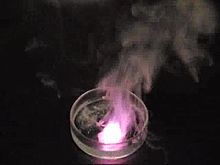Potassium

Potassium is the 19th element on the periodic table of elements, and is the seventh most abundant element in the Earth's crust.[2] Some of its properties are listed below:[2]
| Atomic weight | 39.098 |
| Density (at 0oC) | .089 g/cm3 |
| Boiling point | 1032 K |
| Melting point | 336.7 K |
Potassium is an alkali metal. It makes up 2.4% of the Earth's mass. Potassium can be found naturally as mineral (usually igneous) and salt compounds.[2] Despite being a silver coloured mineral in its native form, potassium burns a unique lilac colour when ignited (Figure 2).
Potassium is important for humans and animals as it helps to maintain proper fluid and electrolyte levels in the body.[2] Potassium deficiency can lead to muscle cramps.
Potassium Uses

Historically, potassium salts (primarily saltpetre, alum, and potash) were used for a variety of products and activities. Some examples include gun powder and dyeing processes.Records of potassium salt use can be traced back to ancient Rome.[2]
In modern times, the biggest use of potassium is for fertiliser.[2] Many popular agricultural plants need potassium to grow. As the plants grow, they deplete the soil of potassium. The potassium then needs to be replenished before more plants will properly grow and this can be done through fertilising. Potassium has many uses not related to fertiliser though.[4] Since potassium is highly reactive and forms a wide variety of compounds, it can be used to form an equally wide variety of products. Potassium is used as food additive, particularly in the form of baking powder and as a food preservative. It used a range of chemical capacities, both in labs and for industrial uses.[4]
Isotopes
Potassium has three isotopes found in nature:[2]
| Symbol | Natural Abundance |
|---|---|
| 39K | 93.26% |
| 40K | 0.01% |
| 41K | 6.73% |
Video
The video below is from the University of Nottingham's periodic videos project.[5] They have created a complete suite of short videos on every element on the periodic table of elements.
For Further Reading
- Periodic table of elements
- Metal
- Greenhouse effect
- Pollution
- Or explore a random page
References
- ↑ Made internally by a member of the Energy Education team, with information from periodictable.com, Available: http://periodictable.com/Elements/001/index.html
- ↑ 2.0 2.1 2.2 2.3 2.4 2.5 2.6 Royal Society of Chemistry Periodic Table, Potassium [Online], Available: http://www.rsc.org/periodic-table/element/19/potassium
- ↑ MWikiMedia Commons,"Potassium water 20,theora.gov". Accessed on Oct.7, 2018. Available: https://en.wikipedia.org/wiki/File:Potassium_water_20.theora.ogv
- ↑ 4.0 4.1 John Emsley, "Nature’s Building Blocks: An A-Z Guide to the Elements", Oxford University Press, New York, 2nd Edition, 2011.
- ↑ See more videos from the University of Nottingham on different elements here: http://www.periodicvideos.com/

